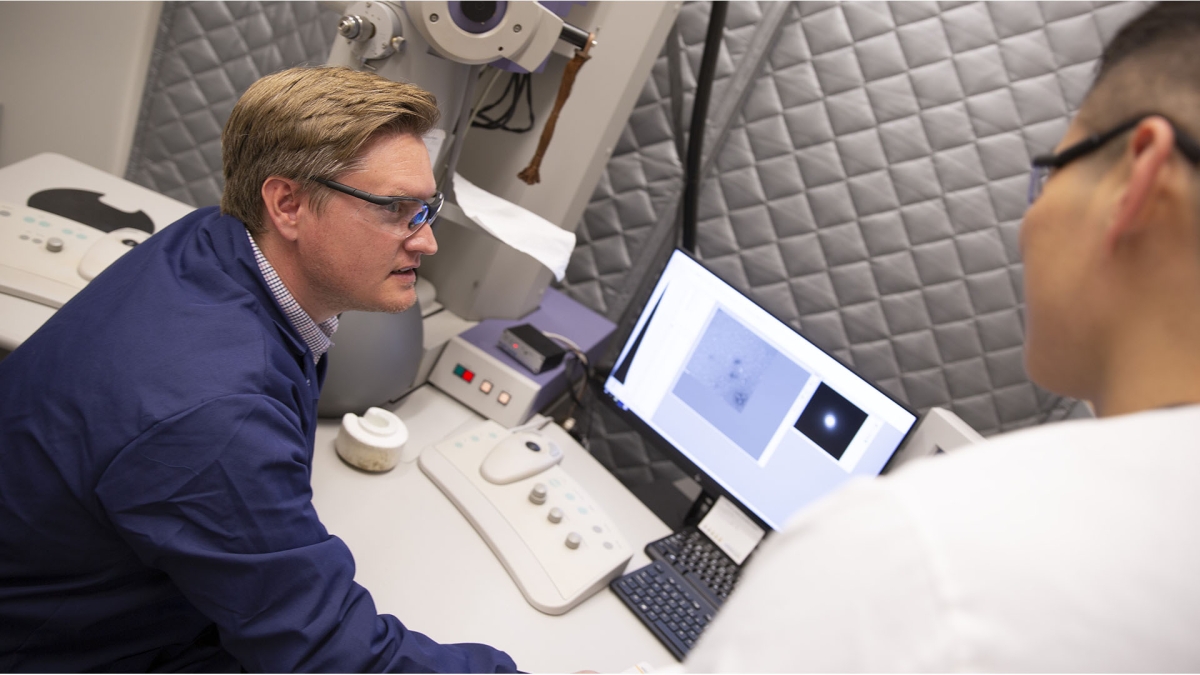ASU professor honored for chemical engineering innovation

Brent Nannenga conducts research in his Arizona State University lab, where he helped develop the innovative technique called microcrystal electron diffraction, or MicroED. The associate professor of chemical engineering in the Ira A. Fulton Schools of Engineering recently earned recognition for his work with an Early Career Impact Award from the University of Washington, where he earned his doctoral degree. Photo by Erika Gronek/ASU
Brent Nannenga, an associate professor of chemical engineering in the Ira A. Fulton Schools of Engineering at Arizona State University, is being recognized with an Early Career Impact Award from his alma mater, the University of Washington. The award recognizes a graduate who has made significant contributions to engineering in industry, academia, government or public or volunteer service within 15 years of receiving their degree.
“Brent was selected for this departmental award on the basis of his stellar achievements in research and teaching,” says Jim Pfaendtner, chemical engineering department chair and professor of chemistry at the University of Washington. “The drive and creativity he displayed as a graduate student in our department have been on full display during the first phase of his independent faculty career. We are so proud of his excellent work.”
Nannenga earned both his bachelor’s and master’s degrees in chemical engineering from ASU before pursuing his doctoral degree from the University of Washington. He credits the program for preparing him for success as a researcher and instructor at ASU.
“It was a really supportive environment. It was what I needed at that time in my life to really grow: awesome mentorship and top quality research,” he says. “I definitely don’t think I’d be here without the experiences I had at the University of Washington.”
Nannenga says his doctoral adviser, François Baneyx, vice provost for innovation and Charles W.H. Matthaei Professor of Chemical Engineering at the University of Washington, was particularly impactful.
“He was an outstanding adviser, and I owe a ton to his mentorship,” Nannenga says. “The way I run my lab and the way I mentor students, I learned from him, which is why this award back in my home department at the University of Washington is so exciting. It recognizes how much the programs really offered me.”
Baneyx says, “Brent has the unique blend of creativity, intellect and grit that characterizes the best researchers, and the deep-seated desire to mentor, teach and elevate others that defines the best teachers. I couldn’t be prouder of his accomplishments.”
At this point in his career, Nannenga’s most impactful innovation is in the field of cryo-electron microscopy. He helped develop a technique called microcrystal electron diffraction, or MicroED. The technique helps better understand the internal structure of a variety of materials on a near-atomic level by freezing a sample and analyzing it with an electron microscope. MicroED allows researchers to examine structures millions of times smaller than the traditional X-ray method.
Knowing the arrangement of atoms and molecules in a substance is invaluable to research in a wide variety of disciplines. The technique is so popular that Nannenga is processing samples from countries around the world. His contributions in crystallographic research earned him the 2022 Margaret C. Etter Early Career Award from the American Crystallographic Association.
Innovative work of this kind requires highly specialized instruments like electron microscopes. Access to this equipment is in part what brought Nannenga back to ASU after completing his postdoctoral work in structural biology at the Janelia Research Campus of the Howard Hughes Medical Institute.
In 2020, Nannenga was recognized by the National Science Foundation with the Faculty Early Career Development Program Award for his work in MicroED and his use of the technique to investigate biological methods to develop nanotechnology. The award is intended to honor faculty with potential to become role models in their field, and provides about half a million dollars to each recipient to support their research.
Though his research is important to him, Nannenga also sought a position at ASU for the opportunity to mentor students. He considers it an honor to work with students as part of his lab group at the School for Engineering of Matter, Transport and Energy, one of the seven Fulton Schools at ASU.
“It’s helpful to work on a project together with students who have different perspectives, and it’s fulfilling to see how students grow. When they first join a lab, I’m telling them how to do everything step by step. Then I watch them slowly grow until, at the end, when they graduate, they’re telling me what they’re doing as opposed to me teaching them. That’s the part I like,” Nannenga says.
There is much on the horizon for Nannenga. He aspires to continue honing the MicroED technique, building relationships with students and forging new paths in chemical engineering. His most recent research focuses on protein engineering and studying the structure-function relationships of these designed proteins.
Nannenga will be presented with the University of Washington Chemical Engineering Early Career Impact Award in fall 2022.
More Science and technology

ASU student-run podcast shares personal stories from the lives of scientists
Everyone has a story.Some are inspirational. Others are cautionary. But most are narratives of a person’s path, sometimes a…

The meteorite effect
By Bret HovellEditor's note: This story is featured in the winter 2025 issue of ASU Thrive.On Nov. 9, 1923, Harvey Nininger saw…

Why your living environment defines how people perceive you
Stereotypes are pervasive.We've all heard of stereotypes based on gender, race, age or religion. But what about making an…